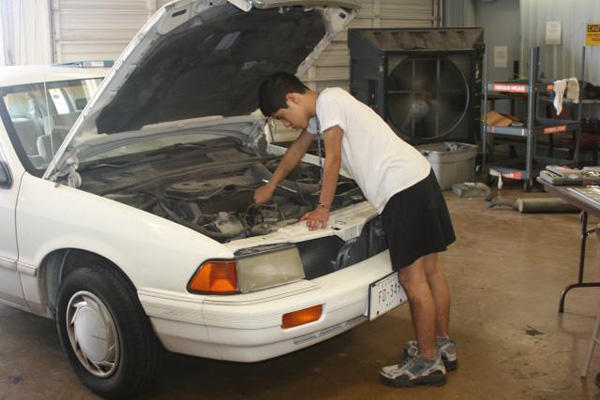Servicing the PCV Valve
The PCV valve (positive crankcase ventilation valve) is a vital part of the emissions controlsystem on most vehicles.
Not every vehicle has a PCV valve, but most do. If yours has one, and if your engine has been idling roughly or a malfunction indicator light goes on, check the PCV valve (shown in Figure 8-5) to make sure that it isn't clogged with sludge from the contaminants in the exhaust fumes or stuck in the wide-open position.

Car manufacturers suggest that PCV valves be cleaned or replaced after somewhere between 20,000 to 50,000 miles of driving. Consult your owner's manual to see where the PCV valve is located on your vehicle and what the recommended service intervals are. The valve is usually replaced during scheduled tune-ups, but depending on its type and location, you may be able to check, clean, and replace it yourself. This section has instructions for doing all the jobs.
Locating the PCV Valve
The PCV valve is usually plugged into a rubber grommet in the valve cover (see Figure 8-6), although it may be located on or near the intake manifold (see Figures 8-6 and 8-7). A hose leading to the PCV valve is often kept in place by a clamp. Sometimes there's a little L-shaped housing on the end of the hose that covers the end of the valve.


Checking the PCV Valve
Tip: There are several ways to check whether your PCV valve is functioning properly. Pick the one that seems easiest for you (the engineshould be idling no matter which method you choose):
- Method 1: Following the instructions in the next section, remove the PCV valve from the valve cover with the hose still attached. Then place your finger over the open end of the hose (see Figure 8-8). If the valve's working well, you will feel strong suction. Try shaking the valve. If it's unobstructed, it should rattle. If it's fouled, the rattle will be indistinct or non-existent.
- Method 2: Remove the cap from the oil filler hole on the valve cover and place a stiff piece of paper over the opening. If your PCV valve is working properly, the paper should be sucked against the hole withinseconds.
If the valve doesn't seem to be working properly, before you go to the trouble to replace it, try cleaning it to see if that makes a difference (see the later section that covers cleaning the valve). If that doesn't work, replace it with a new valve (following the instructions in the next section). The good news is a PCV valve isn't terriblyexpensive.

Removing and Replacing the PCV Valve
Follow these instructions to remove your vehicle's PCV valve in order tocheck, clean, or replace it with a new one:
1. Locate the PCV valve and loosen the hose clamp if there is one, or pull the little L-shaped housing off the end of the valve.
2. Remove the valve. Some PCV valves are held in place with a rubber grommet and can just be pulled free. Others are threaded into place. If you can't unscrew the valve by hand, try to grasp its base with the open end of a combination wrench or a small crescent wrench.
3. While you have the PCV valve off, check the hose and the hose clamps or grommet. (You don't want to have to make two trips to the auto parts store!) Remove the hose and blow through it. If the hose is dry, brittle, soft, spongy, or full of sludge or hard deposits, you should replace it. If the clamps are rusty or the grommet looks deteriorated, you should replace them, too.
4. If the new valve screws into place, do this by hand to avoid stripping the threads in the valve cover. Make sure that the valve is seated securely (it should stick just a little when you try to unscrew it again), but don't over-tighten it!
5. Reconnect the hose to the PCV valve.
6. Start the engine, and check around the PCV valve for leaks.
Cleaning the PCV Valve
If your vehicle's PCV valve isn't working, you can clean it yourself by immersing it in carburetor cleaner or solvent your auto supply store deems suitable. There should be no gummy deposits or discoloration on a clean valve. If your PCV valve must be replaced, buy a new one, remove the old valve, and insert the new one in its place (refer to the previous section for instructions onreplacement).
From Auto Repair for Dummies, copyright © 2009 by Wiley Publishing, Inc., Indianapolis, Indiana. Used by arrangement with John Wiley & Sons, Inc.










